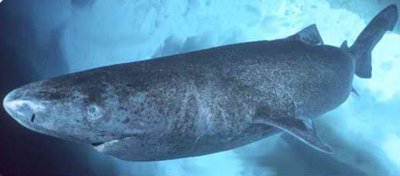Pacific Sleeper Shark
Category: Shark

Facts about Pacific Sleeper Shark, "Scientific name for Pacific Sleeper Shark is Somniosus pacificus". The Pacific Sleeper Shark prefers to swim in deep extremely cold waters. The Pacific Sleeper Shark can however be found anywhere in the world. This species does not auger well with light and avoids it as much as possible coming out of water mostly at night. This should probably explain why it is so hard for human beings to see the pacific sleeper sharks.
The pacific sleeper shark is found anywhere on the planet but most of them are found in Japan on the north pacific along the Siberian coast right into the Bering Sea. You will also find it along the Mexican and Californian coasts; on the Macquarie Island, off Uruguay, south of Tasmania on the seamounts etc
The specific sleeper shark is majorly a scavenger and rarely goes hunting. Like many other sharks, this species is slow but moves with so much elegance and with the least body effort making very minimal movement. The Pacific Sleeper Shark movement is actually what makes it very easy for the shark to capture its prey.
The Pacific Sleeper Sharks feed by cutting on their prey using their teeth and they suction with their large mouths. When swallowing its prey the shark rolls its head.
The pacific sleeper shark has teeth well shaped to suit its feeding. Its upper teeth are very strong and they are shaped in form of a spear while the lower teeth are best suited for slicing. The Pacific Sleeper Sharks is believed to have the strongest bite and can therefore be very dangerous and destructive if they bite you.
The pacific sleeper shark is dark grey in color and is rough to the touch. It has a body that resembles a cylinder and low dorsal fins.
The Pacific Sleeper Shark belongs to the family of somniodidae. The largest pacific sleeper shark is not more than 23 feet (7 meters). The Pacific Sleeper Shark also do not exceed approximately 750 pounds (340kg) in weight.
A mature shark of this species has about 300 hundred eggs and hatching takes place in the mother’s uterus. It is however not very clear how long the gestation period takes.
There are over 400 types of sharks, Sharks have the most powerful jaws on on earth. Pacific Sleeper Sharks jaws, both the upper and lower jaws move. Pacific Sleeper Sharks skin is made of denticles instead of scales like other fish. The denticles are constructed like hard, sharp teeth (tooth-like projection) and this helps to protect the Pacific Sleeper Shark from being injury. The shark is carnivores meaning: an animal that feeds on flesh (Meat).

 Back To Category Shark
Back To Category Shark